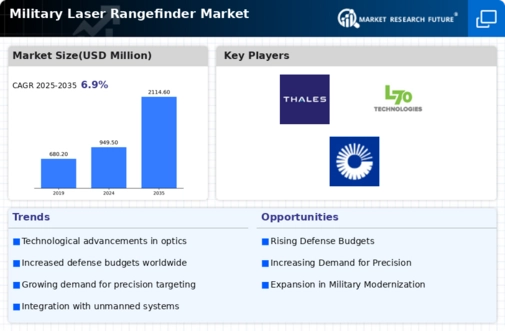Top Industry Leaders in the Military Laser Rangefinder Market

Strategies Adopted: In the intensely competitive Military Laser Rangefinder market, key players employ strategic approaches to maintain a competitive edge. Continuous investment in research and development (R&D) is a cornerstone, allowing companies to introduce next-generation laser rangefinders with enhanced precision, range, and adaptability to different operational environments. Strategic collaborations with military agencies, international partnerships, and alliances facilitate technology transfer and the development of specialized laser rangefinders tailored to specific defense needs. Global market expansion is achieved through participation in defense contracts, international sales, and establishing production facilities in key regions, ensuring a broad market reach and allowing companies to cater to the diverse requirements of defense forces worldwide.
Competitive Landscape of Military Laser Rangefinder Market
- Lockheed Martin Corporation
- Northrop Grumman Corporation
- Leonardo S.p.A
- Thales Group
- L3 Technologies
- UTC Aerospace Systems
- Recent Developments
Factors for Market Share Analysis: Market share analysis in the Military Laser Rangefinder market involves considering various factors crucial to a company's competitive standing. Technical capabilities, such as the ability to offer laser rangefinders with high accuracy, long-range capabilities, and integration with other sensor systems, play a pivotal role. Companies providing adaptable and modular rangefinder solutions capable of addressing diverse military applications, from artillery targeting to sniper systems, are better positioned to capture a larger market share. Compliance with stringent military standards, ruggedness, and integration of advanced technologies like laser designation contribute significantly to market share dynamics. Additionally, factors like ease of use, maintenance support, and overall cost-effectiveness influence a company's market share by enhancing the overall value proposition for defense customers.
New and Emerging Companies: While established players dominate the market, new and emerging companies are making their mark in the Military Laser Rangefinder sector, contributing to innovation and evolution. Companies like Safran Electronics & Defense and Jenoptik AG are gaining recognition for their specialized laser rangefinder solutions, often focusing on compact designs, advanced beam-steering technologies, and meeting the specific needs of modern military applications. Emerging companies often bring agility and a fresh perspective to the Military Laser Rangefinder market, introducing novel approaches and technologies that address the evolving requirements of defense forces.
Industry News: Recent industry news in the Military Laser Rangefinder market underscores ongoing developments and trends shaping the sector. Innovations in laser rangefinder miniaturization, advancements in adaptive optics for improved targeting in complex environments, and the integration of artificial intelligence for enhanced target recognition are gaining prominence. News often covers developments in long-range laser rangefinders for artillery systems, advancements in eye-safe laser technology, and the incorporation of rangefinders into integrated soldier systems. Additionally, the market is witnessing news related to the introduction of laser rangefinders with enhanced resistance to laser countermeasures and developments in laser rangefinders for unmanned aerial vehicles (UAVs). Industry news reflects the dynamic nature of the Military Laser Rangefinder market, with continuous efforts to improve accuracy, range, and overall functionality.
Current Company Investment Trends: Investment trends in the Military Laser Rangefinder market underscore a commitment to technological innovation, miniaturization, and global market reach. Companies are allocating substantial resources to R&D initiatives focused on advanced laser technologies, beam-steering mechanisms, and integration with networked battlefield systems. Investments in sustainability practices, including the development of energy-efficient laser rangefinders, align with the defense industry's broader environmental goals. Strategic acquisitions of technology startups specializing in laser rangefinder applications, partnerships with research institutions, and collaborations with international defense contractors contribute to a comprehensive approach, ensuring a continuous stream of cutting-edge solutions and maintaining a competitive stance in the market.
Overall Competitive Scenario: The overall competitive scenario in the Military Laser Rangefinder market reflects a balance between established industry leaders and emerging companies that bring innovation and flexibility to the sector. Established defense contractors leverage their extensive experience, global reach, and comprehensive laser rangefinder portfolios to set industry standards. Simultaneously, emerging companies contribute to the diversification of Military Laser Rangefinder solutions, often focusing on specific applications or introducing disruptive technologies. The industry's response to evolving military requirements, technological advancements, and emerging threats highlights the adaptability and resilience of laser rangefinder providers. As defense forces globally seek more advanced and versatile rangefinder solutions, the Military Laser Rangefinder market is poised for continued evolution. The emphasis on technological advancements, strategic collaborations, and meeting the dynamic needs of modern warfare positions this market as a critical enabler for military capabilities in precision targeting, situational awareness, and strategic operations.
Recent Development:Top of Form
March 2023: Raytheon Technologies received a $230 million contract from the US Air Force for 1500 Storm Breaker smart weapons, featuring a tri-mode seeker and multi-effects warhead for superior performance against moving targets in all weather conditions.
March 2023: Northrop Grumman secured an initial production and operations contract from the US Marine Corps to develop the Next Generation Handheld Targeting System (NGHTS), a laser-based device enhancing Marines' target identification and designation capabilities.
February 2023: Bharat Dynamics Limited (BDL) signed an MoU with Thales Group to establish a manufacturing facility in India for precision-strike 70mm laser-guided rockets (FZ275 LGR).
September 2022: BAE Systems introduced a compact, cost-effective laser weapon system providing advanced air defense capabilities against unmanned aerial systems.
July 2022: Northrop Grumman completed a preliminary design review for a high-energy laser utilizing coherent beam-combining technology, allowing scalable power by combining high-power laser beams into a single beam.


